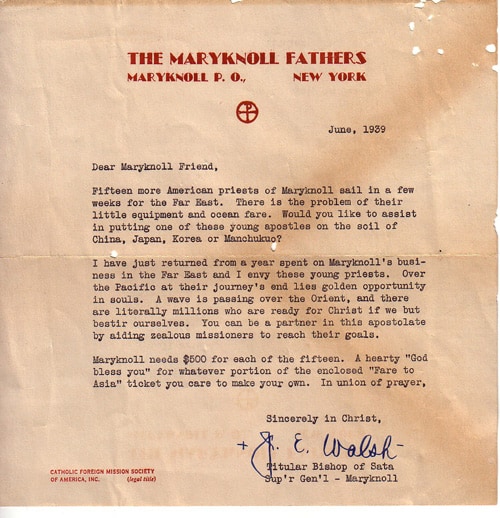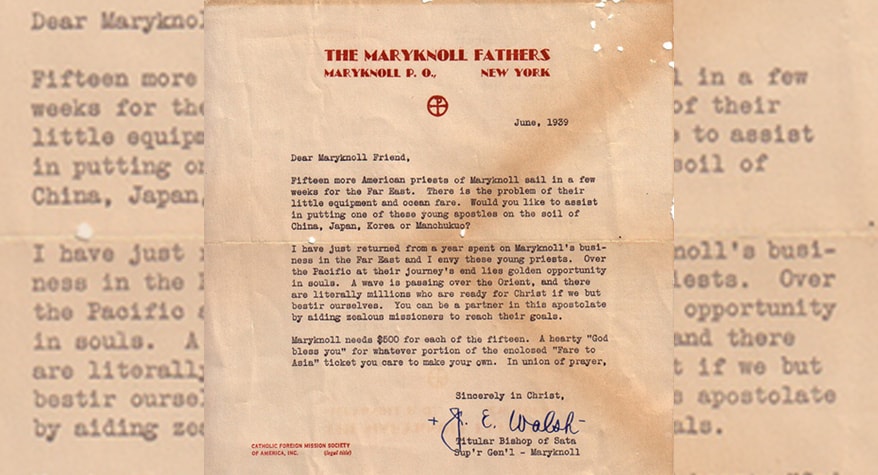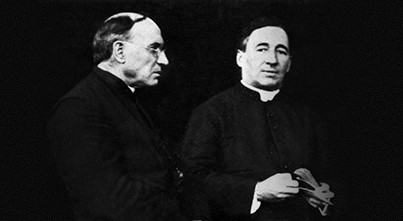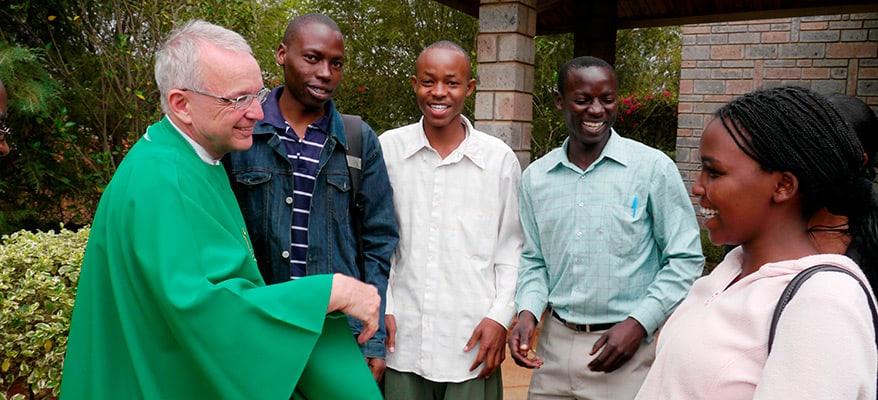72-Year-Old Maryknoll Fundraising Letter Found in Massachusetts
During June of 2011, the centennial year of the Maryknoll Society, a surprise phone call was received from a homeowner who wanted to share her discovery of a piece of Maryknoll history.
The call came from Massachusetts. The discovery of an old fund-raising letter was made in a home in Malden, about five miles away from the Cambridge birthplace of Society co-founder Father (later Bishop) James A. Walsh.
Julianne Orsino advised Maryknoll that she had found a discolored piece of stationary from The Maryknoll Fathers that contained a letter dated June 1939. The approximate seven-and-one-quarter inch square letter was addressed “Dear Maryknoll Friend.” It carried the signature of the “Titular Bishop of Sata, Sup’r Gen’l – Maryknoll” — Bishop James E. Walsh.
Bishop James E. Walsh and Maryknoll
James E. Walsh had entered the first class of Maryknoll during 1912. On December 7, 1915, he became the second priest ordained by the Society. Three years later, he was assigned to China. Pope Pius XI named him, at age 36, the first bishop of the Vicariate of Kongmoon. The missioner, to whom the Chinese Catholics gave the name of Wha Lee Son (Pillar of Truth), was ordained Shepherd of the Church on May 22, 1927, on Sancian Island, the place of death of St. Francis Xavier.
During 1936, Bishop James E. Walsh returned to Maryknoll’s home in New York’s Westchester County following the death of co-founder Bishop James A. Walsh. In April of that year, he was elected the second Superior General of the Maryknoll Society and, during his 10-year term, he supervised Maryknoll’s first missions in Latin America and Africa. After the completion of his term, and at the Vatican’s request, Bishop Walsh returned to China in 1948 as head of the Catholic Central Bureau in Shanghai. His assignment was to coordinate the Church’s missionary efforts throughout China.
When the communists came to power during 1949, all foreign clergy were harassed and pressured to leave. The government, during 1951, ordered Bishop Walsh to close his bureau. When Maryknoll superiors expressed concern for his safety, Bishop Walsh betrayed a trace of his Irish temper: “To put up with a little inconvenience at my age is nothing. Besides, I am a little sick and tired of being pushed around on account of my religion.”
Arrested on October 18, 1959, Bishop Walsh was sentenced to 20 years in prison. During those years in jail, he didn’t receive any news reports. Only one non-Chinese visitor was permitted to see him — his brother and former Maryland State Attorney General William C. Walsh.
Without notice, Bishop Walsh was freed from Shanghai’s prison hospital after serving almost 12 years of his sentence. Clad in rumpled khaki trousers and a faded checkered shirt, he walked across Hong Kong’s Lo Wu Bridge to freedom on July 10, 1970.
He returned to Maryknoll in New York and died peacefully on July 29, 1981, completing 66 years as a priest and 54 as a bishop and having celebrated his 90th birthday. A funeral mass was celebrated at St. Patrick’s Cathedral with Terence Cardinal Cooke as principal celebrant.
Letter Resides In Archives
Ms. Orsino indicated that the discovery of the letter was made during home renovations. The letter possibly remained in house rafters for more than 60 years. Other than the discoloration, a few small holes, a tear and a crease mark in the middle that probably was made when it was mailed, the letter is in very good condition.
The three-paragraph letter indicates that 15 American priests would soon sail for the Far East and that assistance would be needed for “their equipment and ocean fare.” To send Maryknollers to China, Japan, Korea, or Manchukuo, $500 was needed for each priest.
The letter, which is pictured here, has been presented to the Maryknoll Archives. Maryknoll’s appreciation has been extended to Julianne Orsino for her discovery and for contacting the Society.





